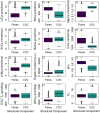Correlative geochemical imaging of Desmophyllum dianthus reveals biomineralisation strategy as a key coral vital effect
- PMID: 38750108
- PMCID: PMC11096413
- DOI: 10.1038/s41598-024-61772-2
Correlative geochemical imaging of Desmophyllum dianthus reveals biomineralisation strategy as a key coral vital effect
Abstract
The chemical and isotopic composition of stony coral skeletons form an important archive of past climate. However, these reconstructions are largely based on empirical relationships often complicated by "vital effects" arising from uncertain physiological processes of the coral holobiont. The skeletons of deep-sea corals, such as Desmophyllum dianthus, are characterised by micron-scale or larger geochemical heterogeneity associated with: (1) centres of calcification (COCs) where nucleation of new skeleton begins, and (2) fibres that thicken the skeleton. These features are difficult to sample cleanly using traditional techniques, resulting in uncertainty surrounding both the causes of geochemical differences and their influence on environmental signals. Here we combine optical, and in-situ chemical and isotopic, imaging tools across a range of spatial resolutions (~ 100 nm to 10 s of μm) in a correlative multimodal imaging (CMI) approach to isolate the microstructural geochemistry of each component. This reveals COCs are characterised by higher organic content, Mg, Li and Sr and lower U, B and δ11B compared to fibres, reflecting the contrasting biomineralisation mechanisms employed to construct each feature. CMI is rarely applied in Environmental/Earth Sciences, but here we illustrate the power of this approach to unpick the "vital effects" in D. dianthus, and by extension, other scleractinian corals.
© 2024. The Author(s).
Conflict of interest statement
The authors declare no competing interests.
Figures






Similar articles
-
The two-step mode of growth in the scleractinian coral skeletons from the micrometre to the overall scale.J Struct Biol. 2005 Jun;150(3):319-31. doi: 10.1016/j.jsb.2005.03.004. Epub 2005 Mar 31. J Struct Biol. 2005. PMID: 15890280
-
Anion elements incorporation into corals skeletons: Experimental approach for biomineralization and paleo-proxies.Proc Natl Acad Sci U S A. 2023 Nov 7;120(45):e2306627120. doi: 10.1073/pnas.2306627120. Epub 2023 Nov 2. Proc Natl Acad Sci U S A. 2023. PMID: 37917794 Free PMC article.
-
Out of their depth? Isolated deep populations of the cosmopolitan coral Desmophyllum dianthus may be highly vulnerable to environmental change.PLoS One. 2011;6(5):e19004. doi: 10.1371/journal.pone.0019004. Epub 2011 May 18. PLoS One. 2011. PMID: 21611159 Free PMC article.
-
The Skeleton and Biomineralization Mechanism as Part of the Innate Immune System of Stony Corals.Front Immunol. 2022 Feb 25;13:850338. doi: 10.3389/fimmu.2022.850338. eCollection 2022. Front Immunol. 2022. PMID: 35281045 Free PMC article. Review.
-
Coral skeletal geochemistry as a monitor of inshore water quality.Sci Total Environ. 2016 Oct 1;566-567:652-684. doi: 10.1016/j.scitotenv.2016.05.066. Epub 2016 May 27. Sci Total Environ. 2016. PMID: 27239711 Review.
Cited by
-
Matrix independent and interference free in situ boron isotope analysis by laser ablation MC-ICP-MS/MS.J Anal At Spectrom. 2025 Apr 3;40(5):1309-1322. doi: 10.1039/d5ja00028a. eCollection 2025 May 7. J Anal At Spectrom. 2025. PMID: 40225908 Free PMC article.
References
-
- de Groot R, et al. Global estimates of the value of ecosystems and their services in monetary units. Ecosyst. Serv. 2012;1:50–61. doi: 10.1016/j.ecoser.2012.07.005. - DOI
-
- Robinson LF, et al. The geochemistry of deep-sea coral skeletons: A review of vital effects and applications for palaeoceanography. Deep-Sea Res. Part. 2014;II(99):184–198. doi: 10.1016/j.dsr2.2013.06.005. - DOI
MeSH terms
Grants and funding
LinkOut - more resources
Full Text Sources
Research Materials
Miscellaneous

